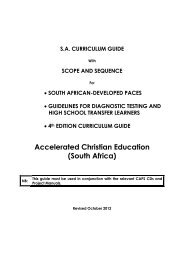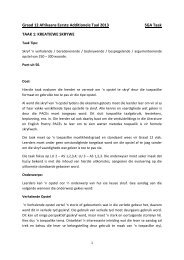SECTION IV Photography Division - ACE Ministries
SECTION IV Photography Division - ACE Ministries
SECTION IV Photography Division - ACE Ministries
You also want an ePaper? Increase the reach of your titles
YUMPU automatically turns print PDFs into web optimized ePapers that Google loves.
GENERAL GUIDELINES<br />
<strong>SECTION</strong> <strong>IV</strong><br />
<strong>Photography</strong> <strong>Division</strong><br />
TYPES OF ENTRIES<br />
There are two classifications: Color and Monochromatic (black and white, sepia and<br />
grayscale). Contestants may enter any of the classifications in the following categories.<br />
Contestants may use any camera for all categories.<br />
1. Scenic—A picturesque outdoor setting.<br />
2. Still Life—A picturesque indoor arrangement of objects.<br />
3. Plants and Animals––A picture of living animals, birds, insects, etc., taken in their<br />
natural or unnatural habitat (zoo pictures permitted) or a picture of living flowers<br />
or plants taken in their natural or unnatural habitat (botanical gardens are<br />
permitted).<br />
4. Special Effects—(color only) TRICK PHOTOGRAPHY using objects, lighting,<br />
lenses, or other equipment to create an illusion or unusual effect. Include a<br />
detailed description on the <strong>Photography</strong> Report (CF37) of how you<br />
created your special effect. Computer software (Adobe ® Photoshop ®,<br />
Adobe® Illustrator®, CorelDRAW ®, etc.) may not be used.<br />
5. Character Trait Picture—A picture that portrays one of the sixty character traits<br />
listed below. The Character Trait must be listed on the 3" x 5" card<br />
attached to your entry.<br />
Appreciative Creative Fearless Merciful Responsible<br />
Attentive Decisive Flexible Observant Secure<br />
Available Deferent Forgiving Optimistic Self-Controlled<br />
Committed Dependable Friendly Patient Sincere<br />
Compassionate Determined Generous Peaceful Submissive<br />
Concerned Diligent Gentle Perseverant Tactful<br />
Confident Discerning Honest Persuasive Temperate<br />
Considerate Discreet Humble Prudent Thorough<br />
Consistent Efficient Joyful Punctual Thrifty<br />
Content Equitable Kind Purposeful Tolerant<br />
Cooperative Fair Loyal Resourceful Truthful<br />
Courageous Faithful Meek Respectful Virtuous<br />
All Africa Student Convention Guidelines – 2011 Revision<br />
Section <strong>IV</strong>: <strong>Photography</strong><br />
1
7. Computer Photo Enhancement (Color Only)—a photographic image (picture) taken<br />
with a film or digital camera and enhanced with computer software programs<br />
(such as Adobe ® Photoshop ®, Adobe® Illustrator®, CorelDRAW ®). Anything<br />
may be done to enhance the photographic image as long as it meets A.C.E.<br />
guidelines.<br />
COLOR AND MONOCHROMATIC RULES<br />
1. Entries must have been taken after the completion of the previous All Africa<br />
Student Convention and must not have been entered in any other contest.<br />
2. Entries must be the sole work of the student.<br />
3. Entries should be approximately 8" x 10" (20 x 25cm) mounted with a mat<br />
(board) approximately 11" x 14" (27.5 x 35 cm) - no frames.<br />
Example of how photograph<br />
should be mounted.<br />
4. Entries must arrive for judging in satisfactory exhibition condition.<br />
5. A.C.E. is not responsible for entries lost or damaged.<br />
6. Subjects in entries MUST conform to A.C.E. Student Convention dress<br />
standards.<br />
7. Each photo may be entered in only one event.<br />
8. Students may use any camera for all entries. Computer software (such as Adobe<br />
® Photoshop ®, Adobe® Illustrator®, CorelDRAW ®) may be used for red eye,<br />
cropping, rotating, color balance and tonal adjustment (lightness, darkness, and<br />
contrast—not enhancement), and printing only. No other enhancement allowed in<br />
these categories.<br />
COMPUTER PHOTO ENHANCEMENT ADDITIONAL RULES<br />
1. Computer Photo Enhancement is a photographic image (picture) taken with a film<br />
or digital camera and enhanced with computer software programs (Adobe<br />
Photoshop or Illustrator, Corel Draw, or other image enhancing programs).<br />
Anything may be done to enhance the photographic image as long as it meets<br />
A.C.E. guidelines.<br />
2. Objects may be added or deleted from the image (picture). For example, an<br />
object may be removed and added to a new environment, or objects can be<br />
added to create a new environment. Text may be added to make a poster, church<br />
bulletin, greeting card, etc.<br />
3. The student must attach the original photographic image (picture) on the back of<br />
the enhanced photo for comparison purposes.<br />
<strong>Photography</strong> should not be entered as a ‘filler’ event. Students who want to take part<br />
should be familiar with terms like focal point, composition and focus. They should take<br />
at least 50 photos before selecting the best print.<br />
All Africa Student Convention Guidelines – 2011 Revision<br />
Section <strong>IV</strong>: <strong>Photography</strong><br />
2
Checklist for <strong>Photography</strong>:<br />
For Regional Convention and International Convention:<br />
1. Each entry must be labeled with a 3" x 5" card securely<br />
attached to the back of the mat with the following<br />
information: entry (Character Trait portrayed if entering<br />
Character Trait picture), student’s name, school name,<br />
customer number, school address, city, province/region,<br />
Postal Code.<br />
2. <strong>Photography</strong> Report (CF37) is only required for Special<br />
Effects (securely attached to the back of the entry).<br />
3. Judge’s Forms (CF38)—Three (3) copies with name,<br />
school, customer number, address, and entry.<br />
Using tape, attach forms and the card mentioned in point 1 above to the back of the<br />
photo in a clear plastic sleeve. DO NOT USE staples as these damage other photos. DO<br />
NOT include additional/unnecessary forms.<br />
Note to Sponsor: Be sure the contestant enters the correct category. Review the<br />
Judge’s Forms to see where points are given and make sure that the entry includes each<br />
point.<br />
CRITERIA<br />
Meets A.C.E. Guidelines—The subject matter or topic treated must conform to<br />
A.C.E. standards of what is acceptable in behavior, dress, etc.<br />
Composition—The visual process of organizing the elements and individual details of a<br />
scene into a balanced and pleasing arrangement.<br />
Mounting—The color, texture, and permanence of the material on which the<br />
photograph is exhibited.<br />
HINTS FROM THE PHOTOGRAPHY JUDGES<br />
Judges will pay close attention to the technical qualities of your work. Next to<br />
content comes composition. This includes the number of subjects, their<br />
arrangements, and the background of the picture. When composing, keep your<br />
photography simple. Too much symbolism or clutter is distracting to the viewer.<br />
Avoid placing the main subject “dead center.” This produces a dull, static effect,<br />
which is not very pleasing to the eye. After composing the photo, carefully check<br />
the background for distracting, objectionable elements. Many fine shots have<br />
been ruined by ugly telephone wires or distracting blotches of color that detract<br />
from the main subject. Nothing in the photo, even though in the background and<br />
out of focus, should violate the A.C.E. standard of dress, behavior, etc. Finally, pay<br />
close attention to the finishing touches. Your photo should be clean and free of<br />
scratches, dust specks, or wrinkles, and should be matted attractively. Often<br />
these are the factors that are used to break ties.<br />
All Africa Student Convention Guidelines – 2011 Revision<br />
Section <strong>IV</strong>: <strong>Photography</strong><br />
3
PHOTOGRAPHY JUDGING CRITERIA<br />
AREAS OF EVALUATION POSSIBLE POINTS<br />
Meets A.C.E. Guidelines (1-5)<br />
Composition<br />
A. First glance: pleasing presentation-human interest or photo<br />
desirable to be displayed, a story conveyed (1-10)<br />
B. Distracting elements eliminated (1-5)<br />
C. The photo has a main subject of interest (1-5)<br />
D. Rule of thirds, framing, contrast, etc. (1-5)<br />
E. Purpose, visual impact, theme visualized (1-10)<br />
F. Evidence of creative effort to achieve the image (1-10)<br />
Technical Expertise<br />
A. Subject in sharp focus, depth of field used creatively,<br />
(camera’s automatic features used with understanding),<br />
no visible defects (1-5)<br />
B. Good composition, flow and balance subject matter. Image<br />
does not violate standard photographic principles (rule of<br />
thirds, balance, framing, etc.). (1-5)<br />
C. Photographic print demonstrates full tonal quality, dynamic<br />
range, and good contrast ratio. Student is responsible for<br />
effective printing of photo from either film negative or jpeg<br />
image file. (1-5)<br />
D. Creative effects used: filters, lights, special lenses (1-5)<br />
E. Darkroom: Film developing demonstrates good understanding<br />
of darkroom techniques to produce quality photo (unloading<br />
film using developing chemicals, using enlarger, proper final<br />
exposure, quality final print). Show procedure record of all<br />
steps. OR<br />
Digital Darkroom: Import image file into computer for colour<br />
balance or tonal adjustments (lightness, darkness, contrast –<br />
not enhancement). Sizing, cropping, scaling, rotating, and<br />
image cleanup spot and scratch removal. Remove any red-eye<br />
with appropriate tools and sharpen image. (1-15)<br />
Mounting (Mat)<br />
A. Mounting board and print reflect a permanent display (1-5)<br />
B. Colour and texture match the subject (1-5)<br />
Proper documentation submitted (1-5)<br />
TOTAL POINTS 100<br />
All Africa Student Convention Guidelines – 2011 Revision<br />
Section <strong>IV</strong>: <strong>Photography</strong><br />
4







